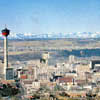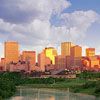Urban Communities
 Alberta in the 20th century, particularly in the decades following World War II, witnessed the rapid urbanization of its population. The most striking immediate change accompanying urbanization is the transition in the prevailing character of Alberta's local communities. As agriculture, local services, and small-scale industry give way to the emergence of modern industry and post-industrial services, cities soon develop-economically and demographically-leaving Alberta's small towns to cling to their history and agricultural roots. In 1901, only a few years prior to Alberta's official birth as a province, 75 percent of the population lived in a rural setting. A century later, that number has substantially dropped to 19 percent and it continues to plummet.
Alberta in the 20th century, particularly in the decades following World War II, witnessed the rapid urbanization of its population. The most striking immediate change accompanying urbanization is the transition in the prevailing character of Alberta's local communities. As agriculture, local services, and small-scale industry give way to the emergence of modern industry and post-industrial services, cities soon develop-economically and demographically-leaving Alberta's small towns to cling to their history and agricultural roots. In 1901, only a few years prior to Alberta's official birth as a province, 75 percent of the population lived in a rural setting. A century later, that number has substantially dropped to 19 percent and it continues to plummet.
 Younger generations within the farming community, including Estonians living throughout the province, have not been immune to the lure of the urban environment. Keeping in mind that the majority of post-World War II Estonian immigrants settled in Canada's larger centres, cities such as Toronto, Calgary, and Edmonton, this section will examine Estonian culture in Calgary and Edmonton. There will be a keen focus on the efforts made by members of the urban community in preserving and promoting Estonian customs and traditions, largely through the establishment of organizations.
Younger generations within the farming community, including Estonians living throughout the province, have not been immune to the lure of the urban environment. Keeping in mind that the majority of post-World War II Estonian immigrants settled in Canada's larger centres, cities such as Toronto, Calgary, and Edmonton, this section will examine Estonian culture in Calgary and Edmonton. There will be a keen focus on the efforts made by members of the urban community in preserving and promoting Estonian customs and traditions, largely through the establishment of organizations.
Preservation and promotion of Estonian customs and culture in Calgary and Edmonton are examined in detail under Cultural Life - Organizations.








